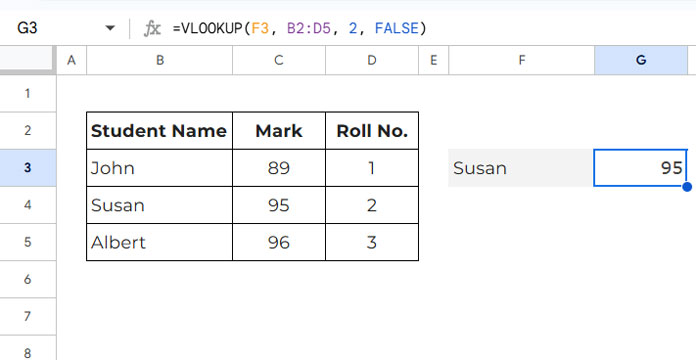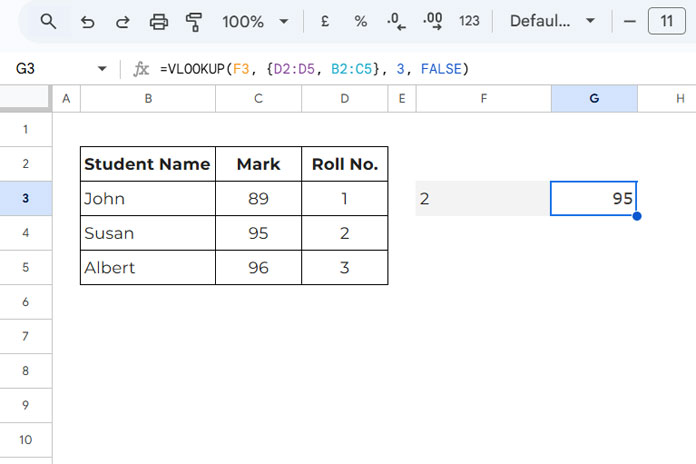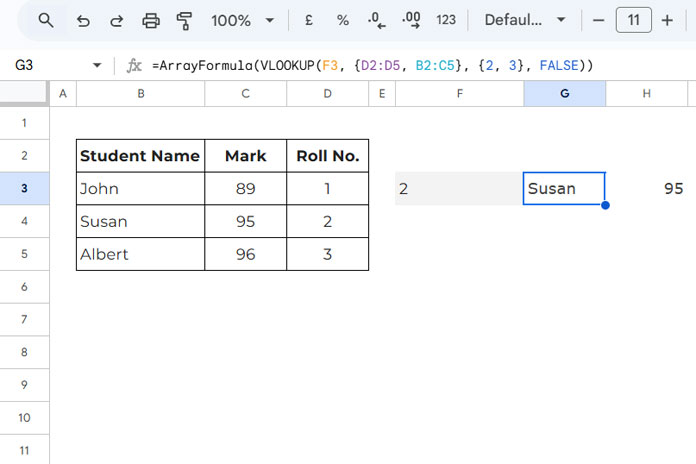We can perform a Reverse VLOOKUP by virtually modifying the range using HSTACK or curly braces in Google Sheets. Of course, alternative solutions like INDEX-MATCH and the modern XLOOKUP function exist. Still, many users rely on VLOOKUP to find data to the left of a table. Do you know why?
Before we get into that, let’s understand what a Reverse VLOOKUP is and how to perform it.
What’s Reverse VLOOKUP in Google Sheets?
Reverse VLOOKUP refers to looking up data from right to left in a table. However, the VLOOKUP function is not designed for this by default.
In a regular VLOOKUP, the search key must be in the first column of your data range. For example, consider this formula:
=VLOOKUP(F3, B2:D5, 2, FALSE)
Here:
- The search key is “Susan” in cell F3.
- The range is B2:D5.
- The formula searches “Susan” in the first column of the range (B2:B5) and returns a value from the second column of the matching row.
Now, let’s look at a different scenario. How do you look up a roll number and return the corresponding student name or mark?
Reverse VLOOKUP addresses this problem effectively.
Reverse VLOOKUP in Google Sheets: How to Perform It
Scenario: Look up roll number 2 entered in cell F3 in the last column of the range B2:D5 and return the mark from the second column.
Here’s the formula:
=VLOOKUP(F3, {D2:D5, B2:C5}, 3, FALSE)
Since VLOOKUP cannot find data to the left, we modified the range virtually. The range is B2:D5, but we want to search in D2:D5. By rearranging the range with curly braces—{D2:D5, B2:C5}—we make D2:D5 the first column.
Now, the fields of the modified range are:
- Column 1: Roll No.
- Column 2: Student Name
- Column 3: Mark
Since the index is 3, the formula returns the mark of roll number 2 from the third column of this modified range.
Watch This Video to Master Reverse VLOOKUP in Google Sheets:
Returning Multiple Values
To return both the name and marks, use this formula:
=ArrayFormula(VLOOKUP(F3, {D2:D5, B2:C5}, {2, 3}, FALSE))
Tip: You can use HSTACK instead of curly braces to modify the range virtually. For example:
=ArrayFormula(VLOOKUP(F3, HSTACK(D2:D5, B2:C5), {2, 3}, FALSE))Find Data Right to Left: Why Choose VLOOKUP over INDEX-MATCH or XLOOKUP?
One key benefit of using VLOOKUP over INDEX-MATCH or XLOOKUP for finding data to the left in Google Sheets is its ability to handle arrays.
Alternatives to Reverse VLOOKUP
Here are equivalent formulas:
- INDEX-MATCH:
=INDEX(B3:C5, MATCH(F3, D3:D5, FALSE))MATCH finds the roll number’s position in D3:D5, and INDEX offsets the rows in B3:C5 accordingly.
- XLOOKUP:
=XLOOKUP(F3, D3:D5, B3:C5)XLOOKUP searches F3 in D3:D5 and returns the corresponding row from B3:C5.
Why VLOOKUP Excels
If you want to look up two roll numbers (e.g., in F3:F4) and return names and marks for both, use this formula:
=ArrayFormula(VLOOKUP(F3:F4, {D2:D5, B2:C5}, {2, 3}, FALSE))The alternatives won’t work directly in such cases, making VLOOKUP a better choice for handling multiple lookups simultaneously.
Resources
- Case-Sensitive Reverse VLOOKUP in Google Sheets
- How to Perform a Reverse HLOOKUP in Google Sheets
- VLOOKUP with Multiple Criteria in Google Sheets: The Proper Way
- Retrieve Multiple Values Using VLOOKUP in Google Sheets
- LOOKUP, VLOOKUP, and HLOOKUP: Key Differences in Google Sheets
- VLOOKUP Last Record in Each Group in Google Sheets
- How to Use VLOOKUP on Duplicates in Google Sheets
- Google Sheets – VLOOKUP Adjacent Cells
- VLOOKUP and XLOOKUP: Key Differences in Google Sheets






















This is great creating a virtual data range using curly braces saves unnecessary rows and makes the sheet cleaner and faster, thank you.
How would this work for an import range?
Hi, John Billings,
Use Query with Importrange to change the column order.
For specific help, please explain the scenario or share a demo sheet.
I tried the below formula. But not successful, please help me.
=VLOOKUP("BIO";{D2:D9;A2:C9};3;0)“Error… In ARRAY_LITERAL, an Array String is missing a value for one or more rows”.
Hi, CHIPHEO,
I could help you. Please leave in the reply, the URL of an example sheet.
— link deleted —-
Thank you for helping me!
Hi, CHIPHEO,
My formula is based on the locale set to the UK. When changing locale you must use the correct separator from comma, semicolon, and backslash.
The issue was the comma use within the array (curly braces). I’ve explained the same in my post – How to Change a Non-Regional Google Sheets Formula.
I’ve added a new tab with the correct formula to use.
The existing reverse Vlookup formula:
=VLOOKUP(E2;{$C$2:$C$7;$A$2:$B$7};3;0)Reverse Vlookup formula after modification:
=VLOOKUP(E2;{$C$2:$C$7\$A$2:$B$7};3;0)Thanks for your help. I am really grateful to you, wish you success.